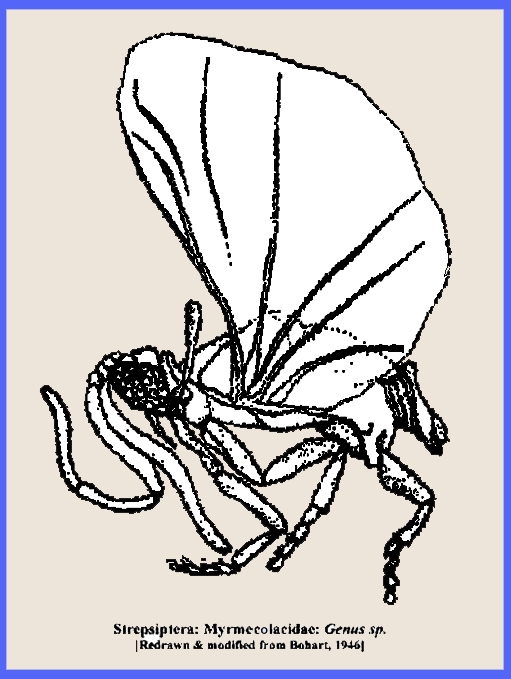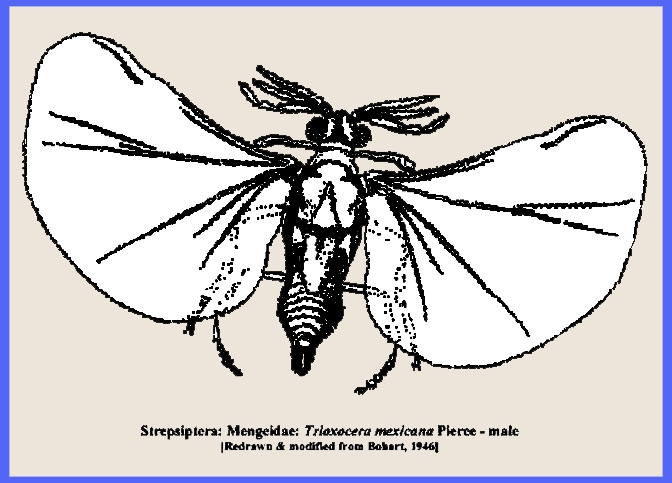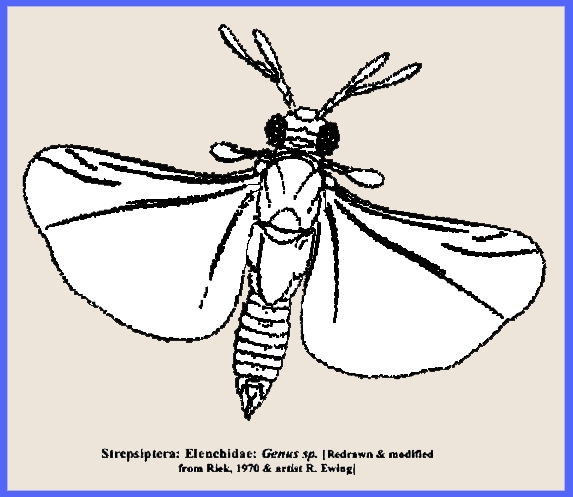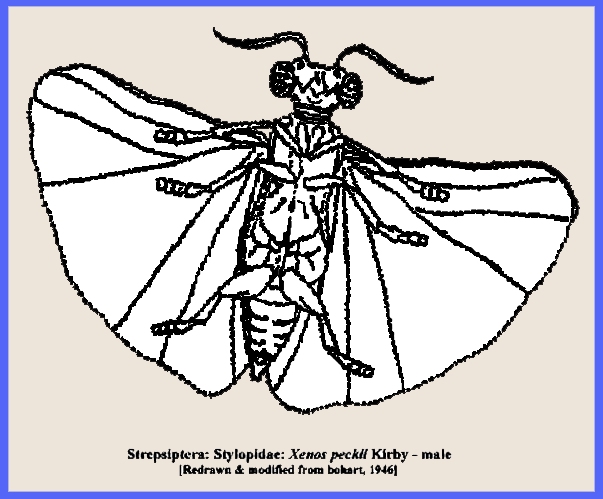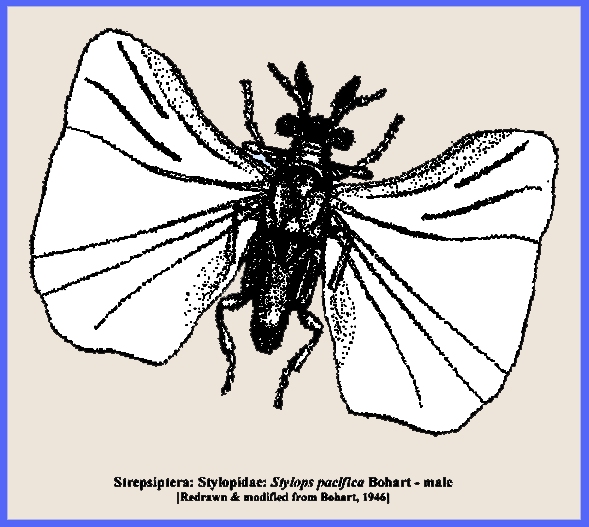File:
<strepsiptera.htm> < (Entomology),
(Invertebrates), (General
Index)> <Invertebrate Bibliography> <Glossary> <Site Description>
< Home>
|
An Introduction To
The Study of Invertebrate Zoology 1 Kingdom: Animalia, Phylum: Arthropoda Subphylum: Hexapoda: Class: Insecta: Order: Strepsiptera (Contact)
Please CLICK on underlined
categories to view and on included illustrations to enlarge: Depress Ctrl/F to search for subject matter:
General Summary of Strepsiptera The Strepsiptera
-- <Adults> & <Juveniles>
-- These insects are characterized by some remarkable biological phenomena.
Their parasitic activity is limited to the growth stages and the adult
female. The adult males are free
living. There is marked sexual dimorphism where the females are prothetelous,
ie., their larva has a body form while they are sexually mature, and they are
all wingless. The eggs may also be polyembryonic. As many as 40 embryos
developing from a single egg, e.g. Halictoxenus parasitic on Halictus
simplex (Hymenoptera). They are usually described as having a type of
hypermetamorphic life cycle in which two larval types exist according as the
development is to be towards a male or female adult. The hosts to which their
parasitic attentions are directed appear to be restricted to the Hymenoptera
(Vespoidea and Apoidea), the Rhynchota (Homoptera), and, in one rare instance
the Orthoptera (Borradaile & Potts,
1958). Among the hymenopterous hosts the
solitary bee Andrena is parasitized
by Stylops. The female is entirely endoparasitic in the host bee, and
appears as a hernia-like extrusion from between the tergites of adjacent
segments as in Polistes. The body of that female is legless and
wingless and composed of a subtriangular unsegmented cephalothorax and a
clearly 10-segmented abdomen. It lies in the host so that the cephalothorax
is visible. Behind the mouth ventrally is a transverse slit which leads into
a brood chamber found under the cuticle of the first five or six abdominal
segments. Genital pores communicate between the internal genital system and
the brood chamber. It is through the
transverse slit on the cephalothorax that copulation with the male occurs. By
way of it, too, are born the first-formed triungulin larvae, the
female being viviparous (Borradaile & Potts,
1958)..
If the resultant individual is a
male, pupation occurs in the host after the head region has projected from
between two abdominal segments of the bee. The casting of the pupal skin
releases the male that flies away to seek a young endoparasitic female on
another bee.
- - - - - - - - - - - - - - - - - - - - Order:
Strepsiptera Kirby Family: Protoxenidae Pohl et al. (fossil record only). -- A male specimen of a
new strepsipteran genus and species (Protoxenos janzeni gen. et sp.
nov.) and family (Protoxenidae fam. nov.) was found in Baltic amber. It shows
features that seem more plesiomorphic than in living strepsipterans, such as laterally
inserted 8-segments antennae, very strong mandibles with a broad base, a well
developed galea, a short, and a transverse metapostnotum. The hindwings are feebly extended. The
abdominal tergites and sternites are lightly sclerotized. Based on a cladistic
analysis of 46 characters of males of 11 genera and three outgroup taxa, P. janzeni
is the sister group of all other known strepsipterans, and Mengea the
sister group of Strepsiptera s.s. Eoxenos is the sister group
of the remaining extant strepsipterans and Mengenillidae. - - - - - - - - - - - - - - - - - - - - Family: Cretostylopidae Kathirithamby
& Engel (fossil record only). --
A male Mesozoic strepsipteran was found in mid-Cretaceous
(Cenomanian) amber from northern Myanmar. Phthanoxenos nervosus Engel and
Huang, gen. et sp. nov., was distinguished from other species, particularly Cretostylops engeli Grimaldi and
Kathirithamby, also in Burmese amber.
Protoxenos janzeni Pohl et al. was found in mid-Eocene Baltic amber, and
assigned to a new family, Phthanoxenidae Engel and Huang, fam. nov. Phthanoxenos has characteristics
of a more primitive phylogenetic position than Cretostylopidae but still more
derived than Protoxenidae. Because Cretostylopidae
and Phthanoxenidae are not the basalmost branches of the Strepsiptera, the
history of the order must extend farther into the Cretaceous and even into
the Jurassic (Grimaldi and Engel, 2005, Grimaldi et al., 2005). The family Cretostylopidae Kathirithamby and Engel
was erected to accommodate the mid-Cretaceous species Cretostylops engeli
(Kathirithamby, & Engel
2014)
Illustrations
being sought - - - - - - - - - - - - - - - - - - - - Suborder Mengenillidia Kinzelbach Family: Mengeidae Pierce (fossil record only). -- Triozocera mexicana Pierce was
found to be parasitic on Pangaeus bilincatus (Say) (Hemiptera: Cydnidae). First descriptions and
illustrations of adult female T. mexicana are given, along with new distribution records. - - - - - - - - - - - - - - - - - - - -
Family: Bahiaxenidae Bravo et al. --
Bahiaxenos relictus is the sole member of the family
Bahiaxenidae, a type of winged insect. It was only discovered and described
in 2009 from relictual sand dunes associated
with the Rio São Francisco in Bahia, Brazil. It is considered to be the most basal living member of
the order Strepsiptera, so is the sister taxon to the remaining extant species. It is known from only a single male specimen, and its
biology is unknown. An adult male of
a newly discovered strepsipteran species from Brazil—Bahiaxenos relictus—is
described. A new family Bahiaxenidae is suggested based on cladistic analyses
of comprehensive morphological data sets with a broad taxon sampling
including the stem group. It is unambiguously placed as the sister group of
all other extant families of Strepsiptera. Bahiaxenos relictus is the
only species of basal, i.e. non‐stylopidian, Strepsiptera occurring in
the New World. It appears to be a relict taxon that has survived in the
fossil sand dunes of the São Francisco River (Bahia State). The loss of the 8th
antennomere and the greatly reduced labrum are autapomorphies of Strepsiptera
s.s. excluding Bahiaxenidae. The sister group relationship
between†Protoxenidae and the remaining Strepsiptera, and between †Cretostylops
and a clade comprising †Mengea and Strepsiptera s.s., is
confirmed, as is the monophyly of Stylopidia and Stylopiformia.
Illustrations
being sought - - - - - - - - - - - - - - - - - - - - Family: Mengenillidae Hofeneder-- The thorax of Mengenilla was examined
using traditional morphological techniques and its features were documented
in detail using scanning electron microscopy and computer-based 3D
reconstructions. The results were compared to conditions found in other
holometabolan insects. The implications for the systematic placement of
Strepsiptera are discussed. The observations are interpreted in the light of
the recently confirmed sistergroup relationship between Strepsiptera and
Coleoptera (Coleopterida). The synapomorphies of the thorax of Strepsiptera
and Coleoptera are partly related with posteromotorism (e.g., increased size
of the metathorax), partly with a decreased intrathoracic flexibility (e.g.,
a fused pronotum and propleurum), and partly independent from these two
character complexes (e.g., not connected profurca and propleuron).
Strepsiptera are more derived than Coleoptera in some thoracic features
(e.g., extremely enlarged metathorax) but have also preserved some
plesiomorphic conditions (e.g., tegulae in both pterothoracic segments). All
potential apomorphies of Mecopterida are missing in Strepsiptera. The last
common ancestor of Coleopterida had already acquired posteromotorism but the
wings were still largely unmodified. Several reductions in the mesothorax
likely occurred independently. - - - - - - - - - - - - - - - - - - - -
Suborder:
Stylopidia Kinzelbach Family: Corioxenidae Kinzelbach (+1 fossil species) . -- The species in this family are parasites of Heteroptera including the Cydnidae, Coreidae, Pentatomidae, Scutelleridae, and Lygaeidae. Males do not have
mandibles. Three recognized subfamilies are separated using morphology of the
males, mainly on the basis of the number of tarsal segments and the presence
of tarsal claws. - - - - - - - - - - - - - - - - - - - - Infraorder: Stylopiformia Kinzelbach
Family: Myrmecolacidae Saunders (+13 fossil species) (Stichotrematidae = Synonym) ). -- There are four genera and about 98 species in
this family. Like all strepsipterans,
they develop as parasites with males parasitizing ants while the females
develop inside Orthoptera. The sexes
differ markedly in morphology so it is difficult to match females to males in
museum specimens. Five new myrmecolacid species (Lychnocolax drysdalensis,
L. maxillaris, Myrmecolax blfurcatus, Stichotremba kuranda
and S. webbiense) were described from Australia. There are also five species described from
Malaysia, New Guinea, the Philippines and Australia. Separate keys exist to the genera of
Myrmecolacidae and to the Australian species. - - - - - - - - - - - - - - - - - - - -
Family: Lychnocolacidae Kathirithambry & Engel?. -- In a phylogenetic study of the insect order Strepsiptera, the
peculiar paleotropical genus Lychnocolax Bohart, 1951 was recovered
as the sister group to Stylopidae + Xenidae.
Bohart maintains that the correct placement of the genus is with
Mymercolacidae and a new family name is not required. Kathirithamby & Engel (2014) did base
the name on an available type genus and included diagnostic characters to differentiate the family from
other groups, but they did not explicitly indicate the name as new (since they erroneously attributed the family name
to Bohart), nor did they specifically note the type genus (even if it was apparent from the formation of the
familial name). This nomenclatural
oversight is corrected utilizing the diagnostic traits outlined in the key of
Kathirithamby & Engel (2014). - - - - - - - - - - - - - - - - - - - -
Family: Stylopidae Kirby (+2 fossil
species)
. -- Stylopidae
is a family of strepsipterans with about
15 genera and more than 330 described species. They are all parasitic
insects. Affected host insects of
this family are noted as being "stylopized". - - - - - - - - - - - - - - - - - - - - Family: Xenidae Saunders. -- The mature insects of this family have unusually large eyes, which
is not unexpected for a group with a complex life cycle. For the Strepsiptera that are believed to
have evolved nocturnally there is little information about their
photoreceptors. Some research has
shown great sensitivity to ultra violet and green light, suggesting the
presence of color vision. This might
aid males of at least one species, Xenos peckii, to find females,
which are hidden in the nests of their wasp hosts. - - - - - - - - - - - - - - - - - - - - Family:
Bohartillidae Kinzelbach (+3 fossil species) .-- Kinzelbach (1969) described the first
species in this new genus, Bohartilla megalognatha from Honduras.
Kathirithamby & Grimaldi (1993) identified this genus in medium yellow
Dominican amber: one male is morphologically indistinguishable from B.
megalognatha, one male matches in several details the extant species and
was named B. kinzelbachi. However, Pohl & Kinzelbach (1995)
synonymised the B. megalognatha from the amber to B.
joachimscheveni described by Kinzelbach & Pohl (1994) from Dominican
amber. The only differences stated by Kinzelbach & Pohl (1994) of B.
megalognatha from the amber from the extant B. megalognatha
are: slender antennae, maxillae and longer legs; longer maxillary palpus. In
other characters the amber specimen generally agrees with those of the extant
species. Kinzelbach & Pohl also state that "as in most other
specimens from the Dominican amber, there are almost no differences from
living representatives at the species level". Kathirithamby &
Grimaldi would like to reinstate B. megalognatha from the Dominican
amber. Another new species from the amber, B. kinzelbachi, was
described by Kathirithamby & Grimaldi (1993), and the length of the basal
maxillary segment of this specimen is 1.5x that of apical palpi. - - - - - - - - - - - - - - - - - - - - Family: Elenchidae Perkins (+1 fossil)
. -- Elenchus japonicus a parasitoid of the
rice planthoppers Nilaparvata lugens (Stål) and Sogatella furcifera
(Horváth) in Southeast Asia (IN; Proceedings of the 8th International
Auchenorrhyncha Congress, Delphi, Greece, 9th -13th August, pg. 64.
Kathirithamby, J. 1993b.) Another
strepsipteran parasitoid Elenchus sp.
parasitizes N. lugens in Malaysia. S canning electron microscope
studies indicate that the parasitoid resembles E. tenvicornis. The free-living male of Elenchus
sp. emerges both from 5th instar nymphs and adults of N. lugens. The neotenic female Elenchus
sp. emerges only from adult hosts. - - - - - - - - - - - - - - - - - - - -
Family: Halictophagidae. -- Coriophagus hansoni n. sp.
is the first in that genus from Central America and the second Coriophagus
species from the New World. Halictophagus
crasiartus n. sp. is the second species described from Costa Rica in this
genus and the third in Central America. A
new species of Halictophagidae (Insecta: Strepsiptera), Halictophagus
forthoodiensis Kathirith- amby & Taylor, is described from Texas,
USA. We also present a key to 5 families, and a check-list of 11 genera and
84 species of Strepsiptera known from USA and Canada. - - - - - - - - - - - - - - - - - - - - Family: Callipharixenidae. -- Callipharixenos muiri Pierce is parasitic in
Calliphara billardierei F. (Heteroptera) from
Cambodia, and C. siamensis Pierce is parasitic in Chrysocoris
grandis Thunberg (Heteroptera) from Cambodia and Thailand (Pierce
1918). Only females and first instar larvae of this family are known.
Their synapomorphies with the higher Stylopidia are: a flattened
cephalothorax, two pairs of functional meso- and metathoracic spiracles and
five genital openings (Kinzelbach
1971). Until males of this species
are found it would be difficult to determine the phylogenetic relationship
with other families of Stylopidia. Males
are unknown - - - - - - - - - - - - - - - - - - - - All Strepsiptera, which were first known as Stylopids,
are parasitic on certain adult insects.
Members of this order were frequently incorporated into the Coleoptera
as a superfamily: Stylopoidea. The males have twisted wings, and the front wing is
reduced to a halter while the hind wing is very elongated and pleated. Females are apterous. Mouthparts are vestigial and nutrients
enter by diffusion from the host. The
male is the free-living active form, while the female spends her entire life
in the abdomen of a host insect. Eggs
hatch and triangulin larvae emerge.
As the parasite larvae mature the female form remains indistinct with
little more than a head, which protrudes from the host segments. The male does leave the host,
however. Insemination of the female occurs on the host. Genitalia of the female are on the cervix
region. After impregnation the female
simply turns into a bundle of eggs.
These egg hatch, releasing triungulin larvae en masse, which then
escape through the body wall of the host.
They seek out a new host by perching on flowers, etc., or wherever
another insect (e.g., bee) might alight. ------------------------------------------- Details of Insect Taxonomic Groups Examples of beneficial species
occur in almost every insect order, and considerable information on
morphology and habits has been assembled.
Therefore, the principal groups of insect parasitoids and predators
provide details that refer to the entire class Insecta. These details are available at <taxnames.htm>. ============== Bravo, F., H.
Pohl, A. Silva-Neto, and R. G. Beutel. 2009. Bahiaxenidae, a ‘‘living
fossil’’ and a new family of Strepsiptera (Hexapoda) discovered in Brazil.
Cladistics 25(6):614–623. Grimaldi, D.,
and M. S. Engel. 2005. Evolution of the Insects. Cambridge University Press,
Cambridge, UK. xv+755 pp. Grimaldi, D., J.
Kathirithamby, and V. Schawaroch. 2005. Strepsiptera and triungula in
Cretaceous amber. Insect Systematics and Evolution 36(1):1–20. Hu¨ nefield, F.,
H. Pohl, B. Wipfler, F. Beckmann, and R. G. Beutel. 2011. The male
postabdomen and genital apparatus of Mengea tertiaria, a strepsipteran amber
fossil (Insecta). Journal of Zoological Systematics and Evolutionary Research
49(4):298–308. Kathirithamby,
J. & M. S. Engel. 2014. A revised key to the living and fossil
families of Strepsiptera, with the description of a new family,
Cretostylopidae. J. Kansas Ent. Soc.
87(4): 385-388. Kinzelbach, R.
K. 1979. Das erste neotropische Fossil der Fa¨cherflu¨ gler (Stuttgarter
Bernsteinsammlung:Insecta, Strepsiptera). Stuttgarter Beitra¨ge zur
Naturkunde, Serie B (Geologie und Pala¨ontologie)53:1–14. McMahon, D. P.,
A. Hayward, and J. Kathirithamby. 2011. The first molecular phylogeny of
Strepsiptera (Insecta) reveals an early burst of molecular evolution
correlated with the transition to endoparasitism. PLoS ONE 6:e21206 [1–10]. Pohl, H., and R.
G. Beutel. 2005. The phylogeny of Strepsiptera (Hexapoda). Cladistics
21(4):328–374. Pohl, H., R. G. Beutel, and R. Kinzelbach. 2005. Protoxenidae
fam. nov. (Insecta, Strepsiptera) from Baltic amber – a ‘missing link’ in
strepsipteran phylogeny. Zoologica Scripta 34(1):57–69.
|

